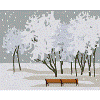Landscape Architecture Program
Rethinking Extensive Green Roofs to Lessening Emphasis on Biomass
Document Type Article
This paper was presented in a poster format at the GRHC Conference in Atlanta, June 2009.
Abstract
Fly into any large Midwestern city, look down and you will see acres of warehouse and commercial roofs. Not merely drab, these roofs’ footprints also exacerbate urban heat islands and local flooding while supplanting local ecosystem function. As an antidote, the shortgrass prairie of the western Great Plains contains native plant species suitable for use on North American green roofs and becomes a model for creating extensive (thin and lightweight) green roof ecosystems (Dunnett 2004, Oberndorfer et al 2007, Sutton 2008). Reviewing what is known of the autecology of the dominant shortgrass prairie species, blue grama (Bouteloua gracilis) and the synecology of shortgrass communities should lead to designers mimicking this unique ecosystem for an extensive green roof. However, it will take a radically different way of thinking about both above and below annual net productivity by ecologists studying prairies and by horticulturists prescribing unsustainable inputs of energy, labor and nutrients.

